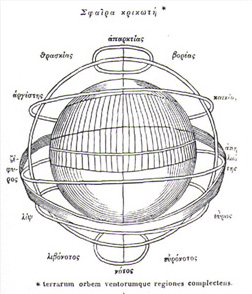The name of the instrument

Diagram of a "sphaira krikote"
by Claudius Ptolemy, 2nd cent. A.D.
from his work "Geographike Hyphegesis"
The first known use of the name of the instrument goes back to Greece in the third century B.C. There scholars called the observation device = meteoroskopeion (Greek for "floating in the air / watch or see"), while they named the instruments for demonstration = sphaira krikote (Greek for "sphere made of rings").
Today's name, "armillary sphere" or "armilla" for short, was first used in Latin manuscripts of the Christian Middle Ages. There it was called "sphaera armillaris", "astrolabium armillare" or "armillae".
The name "armillary sphere" originates from the words "armilla" (Latin for "ring" or "bracelet") and "sphaira" (Greek for "sphere"). It therefore denotes a sphere made of rings. The term "astrolabium armillare" translates as "star-taker-ring".
In Antiquity the Arab astronomers adopted the knowledge from the Greeks and developed it well into the Middle Ages. They gave the armillary sphere the name "âlat dât al halag" (Arabic for "instrument with the rings"), often shortened to "dât al halag". The Arabs, too, regarded armillary spheres very highly, along with astrolabes.

